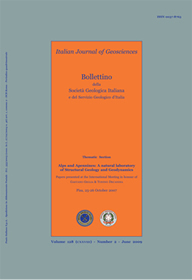
Caratteri sedimentologici e composizionali delle ghiaie del sintema di Poggio Martino, Bacino Plio-Pleistocenico di Tarquinia, Italia centrale
Ugo Chiocchini(*) & Fabio Castaldi(**)
(*) Dipartimento di Geologia, Ingegneria Meccanica, Idraulica e
Naturalistica per il Territorio (GEMINI), Università della Tuscia, Via S. Camillo de Lellis s.n.c. - 01100 Viterbo. E-mail: chiocchi@unitus.it
(**) Dottorato di Ricerca in Scienze e Tecnologie per la Gestione
Forestale e Ambientale - Curriculum di Pianificazione di bacino
idrografico e difesa del suolo, Università della Tuscia, Via S. Camillo de Lellis s.n.c. - 01100 Viterbo.
DOI: https://doi.org/10.3301/IJG.2009.128.3.695
Volume: 128 (2009) f.3
Pages: 695-713
Abstract
The Tarquinia Basin (BARBERI et alii, 1994) in north-western Latium has been filled by a Plio-Pleistocene succession connected to three transgressive depositional cycles. This succession includes the Early Pliocene S. Savino Synthem (circalitoral pelites), followed by the Middle-Late Pliocene Tarquinia Synthem consisting of the two interfingering Macco (skeletal calcarenites and hybrid sands) and Poggio Gallinaro Sands (hybrid sands) members (both foreshore and shoreface deposits) and the Late Pliocene-Early Pleistocene Poggio Martino Synthem member (sands and gravels of shore environment). The last synthem corresponds to the oldest marine terrace, at about 175 m height, among the five Quaternary terraces recognized in the Tarquinia Basin (BOSI et alii, 1990). 646 pebbles have been collected in four sites from the Poggio Martino Synthem gravels, subdividing them into four grain size classes (8-16 mm; 16-32 mm; 32-64 mm; 64-128 mm) by the intermediate axis b. The texture analysis shows that the axis b mean values range between 20,55 mm (site S1) and 33,88 mm (site S4) and the 16-32 mm grain size class includes the majority of clasts. The morphometric analysis, performed by measuring flatness index (CAILLEUX, 1945), dissymmetry index (CAILLEUX, 1945), rounding off index (CAILLEUX, 1945), roundness index (DOBKINS & FOLK, 1970), oblate-prolate (DOBKINS & FOLK, 1970), sphericity index (SNEED & FOLK, 1958) and by detecting the clast forms, suggests that clasts did not undergo a high elaboration, in part due to their lithological characteristics. The compositional analysis allowed to recognize a very high amount of calcareous lithologies (marly limestones, siliceous limestones, calcarenites, quartz rich sandstones, hybrid arenites) coupled with a high frequency of hard and wear resistant clasts like cherts and quartzites. In particular the lower values of roundness, rounding off and flatness have been recognized in sites S2, S3, S4 in which charts and quartzites are more abundant. The texture and morphometric data suggest that the gravels have been transported by streams. The grain size of gravels and the morphometric indexes suggest that streams should have been characterized by a moderate energy and the solid load was deposited in the coastal environment. The gravel source area has been detected in the Mounts Romani sector about 35-40 km NW of the Poggio Martino Synthem area. This sector consists of the Late Cretaceous-Eocene Sillano Formation (GALESTRI AND PALOMBINI of SIGNORINI, 1967) and Tolfa Flysch (unità liguridi; ABBATE & SAGRI, 1970; FAZZINI et alii, 1972; BOCCALETTI et alii, 1987; CIVITELLI & CORDA, 1993), which produced the marly limestones, siliceous limestones, calcarenites, cherts and quartz and mica rich sandstones clasts, of the Triassic Verrucano Formation (ALBERTI et alii, 1970; BOCCALETTI et alii, 1997) from which quartzites are derived, of the Late Messinian Manciano Sandstone (GIANNINI, 1957; SIGNORINI, 1967; PELLEGRINI, 1967a; 1967b; MALESANI & MANETTI, 1967; DESSAU et alii, 1972; FONTANA, 1980a; 1980b; MARTINI et alii, 1995; BARBIERI et alii, 2003) which produced the hybrid arenite clasts and the Late Triassic Calcare cavernoso (ALBERTI et alii, 1970; BOCCALETTI et alii, 1987) immediately SW of the Verrucano Formation which did not produce any supply. The strange lack of Calcare cavernoso clasts in the gravels, despite this formation is widespread on the western side of the Mount Romani till the Argentario Promontory, suggests that the drainage network has not affected the Calcare cavernoso, being confined in a narrow belt of the Mount Romani.
Keywords
Get Full Text